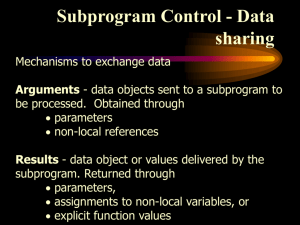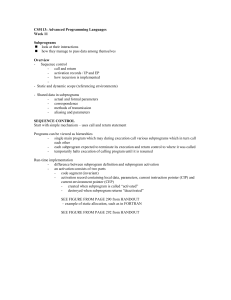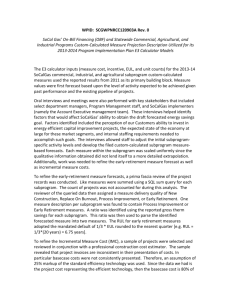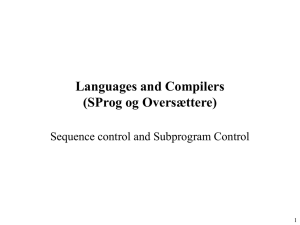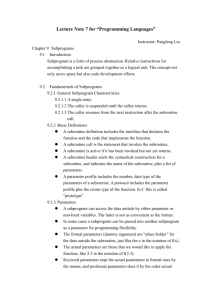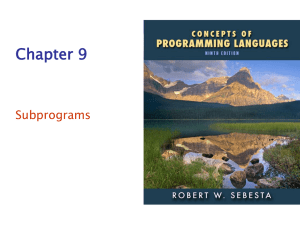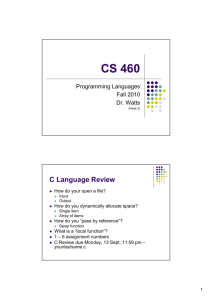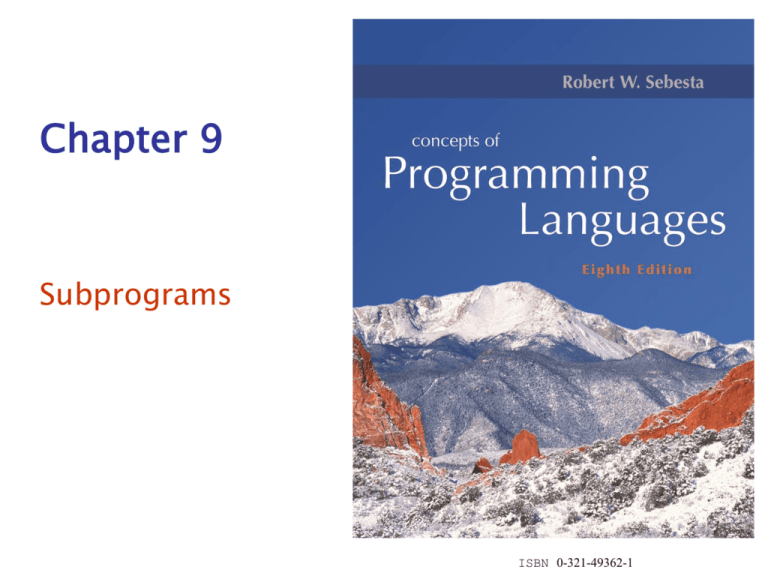
Chapter 9
Subprograms
ISBN 0-321-49362-1
Chapter 9 Topics
•
•
•
•
•
•
•
•
•
•
•
Introduction
Fundamentals of Subprograms
Design Issues for Subprograms
Local Referencing Environments
Parameter-Passing Methods
Parameters That Are Subprograms
Overloaded Subprograms
Generic Subprograms
Design Issues for Functions
User-Defined Overloaded Operators
Coroutines
Copyright © 2007 Addison-Wesley. All rights reserved.
1-2
Introduction
• Two fundamental abstraction facilities
– Process abstraction
• Emphasized from early days
– Data abstraction
• Emphasized in the1980s
Copyright © 2007 Addison-Wesley. All rights reserved.
1-3
Fundamentals of Subprograms
• Each subprogram has a single entry point
• The calling program is suspended during
execution of the called subprogram
• Control always returns to the caller when
the called subprogram’s execution
terminates
Copyright © 2007 Addison-Wesley. All rights reserved.
1-4
Basic Definitions
• A subprogram definition describes the interface to and the
actions of the subprogram abstraction
- In Python, function definitions are executable; in
all other languages, they are non-executable
• A subprogram call is an explicit request that the subprogram
be executed
• A subprogram header is the first part of the definition,
including the name, the kind of subprogram, and the formal
parameters
• The parameter profile (aka signature) of a subprogram is the
number, order, and types of its parameters
• The protocol is a subprogram’s parameter profile and, if it is
a function, its return type
Copyright © 2007 Addison-Wesley. All rights reserved.
1-5
Basic Definitions (continued)
• Function declarations in C and C++ are often
called prototypes
• A subprogram declaration provides the protocol,
but not the body, of the subprogram
• A formal parameter is a dummy variable listed in
the subprogram header and used in the
subprogram
• An actual parameter represents a value or address
used in the subprogram call statement
Copyright © 2007 Addison-Wesley. All rights reserved.
1-6
Actual/Formal Parameter
Correspondence
• Positional
– The binding of actual parameters to formal parameters is
by position: the first actual parameter is bound to the first
formal parameter and so forth
– Safe and effective
• Keyword
– The name of the formal parameter to which an actual
parameter is to be bound is specified with the actual
parameter
– Advantage: Parameters can appear in any order, thereby
avoiding parameter correspondence errors
– Disadvantage: User must know the formal parameter’s
names
Copyright © 2007 Addison-Wesley. All rights reserved.
1-7
Formal Parameter Default Values
• In certain languages (e.g., C++, Python, Ruby, Ada, PHP),
formal parameters can have default values (if no actual
parameter is passed)
– In C++, default parameters must appear last because
parameters are positionally associated
• Variable numbers of parameters
- C# methods can accept a variable number of parameters as
long as they are of the same type—the corresponding formal
parameter is an array preceded by params
- Ruby and Python also support variable numbers of
parameters. In Ruby, the actual parameters are sent as
elements of a hash literal and the corresponding formal
parameter is preceded by an asterisk.
- In Python, the actual is a list of values and the
corresponding formal parameter is a name with an asterisk
Copyright © 2007 Addison-Wesley. All rights reserved.
1-8
Ruby Blocks
•
•
•
Ruby includes a number of iterator functions, which are often used to
process the elements of arrays
Iterators are implemented with blocks, which can also be defined by
applications
Blocks are attached methods calls; they can have parameters (in vertical
bars); they are executed when the method executes a yield statement
def fibonacci(last)
first, second = 1, 1
while first <= last
yield first
first, second = second, first + second
end
end
puts "Fibonacci numbers less than 100 are:"
fibonacci(100) {|num| print num, " "}
puts
Copyright © 2007 Addison-Wesley. All rights reserved.
1-9
Procedures and Functions
• There are two categories of subprograms
– Procedures are collection of statements that
define parameterized computations
– Functions structurally resemble procedures but
are semantically modeled on mathematical
functions
• They are expected to produce no side effects
• In practice, program functions have side effects
Copyright © 2007 Addison-Wesley. All rights reserved.
1-10
Design Issues for Subprograms
• Are local variables static or dynamic?
• Can subprogram definitions appear in other
subprogram definitions?
• What parameter passing methods are provided?
• Are parameter types checked?
• If subprograms can be passed as parameters and
subprograms can be nested, what is the
referencing environment of a passed subprogram?
• Can subprograms be overloaded?
• Can subprogram be generic?
Copyright © 2007 Addison-Wesley. All rights reserved.
1-11
Local Referencing Environments
• Local variables can be stack-dynamic
- Advantages
• Support for recursion
• Storage for locals is shared among some subprograms
– Disadvantages
• Allocation/de-allocation, initialization time
• Indirect addressing
• Subprograms cannot be history sensitive
• Local variables can be static
– Advantages and disadvantages are the opposite of those
for stack-dynamic local variables
Copyright © 2007 Addison-Wesley. All rights reserved.
1-12
Semantic Models of Parameter Passing
• In mode
• Out mode
• Inout mode
Copyright © 2007 Addison-Wesley. All rights reserved.
1-13
Models of Parameter Passing
Copyright © 2007 Addison-Wesley. All rights reserved.
1-14
Conceptual Models of Transfer
• Physically move a path
• Move an access path
Copyright © 2007 Addison-Wesley. All rights reserved.
1-15
Pass-by-Value (In Mode)
• The value of the actual parameter is used to
initialize the corresponding formal parameter
– Normally implemented by copying
– Can be implemented by transmitting an access path but
not recommended (enforcing write protection is not easy)
– Disadvantages (if by physical move): additional storage is
required (stored twice) and the actual move can be costly
(for large parameters)
– Disadvantages (if by access path method): must writeprotect in the called subprogram and accesses cost more
(indirect addressing)
Copyright © 2007 Addison-Wesley. All rights reserved.
1-16
Pass-by-Result (Out Mode)
• When a parameter is passed by result, no
value is transmitted to the subprogram; the
corresponding formal parameter acts as a
local variable; its value is transmitted to
caller’s actual parameter when control is
returned to the caller, by physical move
– Require extra storage location and copy
operation
• Potential problem: sub(p1, p1);
whichever formal parameter is copied back
will represent the current value of p1
Copyright © 2007 Addison-Wesley. All rights reserved.
1-17
Pass-by-Value-Result (inout Mode)
• A combination of pass-by-value and
pass-by-result
• Sometimes called pass-by-copy
• Formal parameters have local storage
• Disadvantages:
– Those of pass-by-result
– Those of pass-by-value
Copyright © 2007 Addison-Wesley. All rights reserved.
1-18
Pass-by-Reference (Inout Mode)
• Pass an access path
• Also called pass-by-sharing
• Advantage: Passing process is efficient (no
copying and no duplicated storage)
• Disadvantages
– Slower accesses (compared to pass-by-value) to
formal parameters
– Potentials for unwanted side effects (collisions)
– Unwanted aliases (access broadened)
Copyright © 2007 Addison-Wesley. All rights reserved.
1-19
Pass-by-Name (Inout Mode)
• By textual substitution
• Formals are bound to an access method at
the time of the call, but actual binding to a
value or address takes place at the time of
a reference or assignment
• Allows flexibility in late binding
Copyright © 2007 Addison-Wesley. All rights reserved.
1-20
Implementing Parameter-Passing
Methods
• In most language parameter
communication takes place thru the runtime stack
• Pass-by-reference are the simplest to
implement; only an address is placed in the
stack
• A subtle but fatal error can occur with
pass-by-reference and pass-by-valueresult: a formal parameter corresponding to
a constant can mistakenly be changed
Copyright © 2007 Addison-Wesley. All rights reserved.
1-21
Parameter Passing Methods of Major
Languages
• C
– Pass-by-value
– Pass-by-reference is achieved by using pointers as parameters
• C++
– A special pointer type called reference type for pass-byreference
• Java
– All parameters are passed by value
– Object parameters are passed by reference
• Ada
– Three semantics modes of parameter transmission: in, out,
in out; in is the default mode
– Formal parameters declared out can be assigned but not
referenced; those declared in can be referenced but not
assigned; in out parameters can be referenced and assigned
Copyright © 2007 Addison-Wesley. All rights reserved.
1-22
Parameter Passing Methods of Major
Languages (continued)
• Fortran 95
- Parameters can be declared to be in, out, or inout mode
• C#
- Default method: pass-by-value
– Pass-by-reference is specified by preceding both a formal
parameter and its actual parameter with ref
• PHP: very similar to C#
• Perl: all actual parameters are implicitly placed in a
predefined array named @_
• Python and Ruby use pass-by-assignment (all data
values are objects)
Copyright © 2007 Addison-Wesley. All rights reserved.
1-23
Type Checking Parameters
• Considered very important for reliability
• FORTRAN 77 and original C: none
• Pascal, FORTRAN 90, Java, and Ada: it is always
required
• ANSI C and C++: choice is made by the user
– Prototypes
• Relatively new languages Perl, JavaScript, and PHP
do not require type checking
• In Python and Ruby, variables do not have types
(objects do), so parameter type checking is not
possible
Copyright © 2007 Addison-Wesley. All rights reserved.
1-24
Multidimensional Arrays as Parameters
• If a multidimensional array is passed to a
subprogram and the subprogram is
separately compiled, the compiler needs to
know the declared size of that array to
build the storage mapping function
Copyright © 2007 Addison-Wesley. All rights reserved.
1-25
Multidimensional Arrays as Parameters:
C and C++
• Programmer is required to include the
declared sizes of all but the first subscript
(e.g. the no. of columns) in the actual
parameter
• Disallows writing flexible subprograms
• Solution: pass a pointer to the array and the
sizes of the dimensions as other
parameters; the user must include the
storage mapping function in terms of the
size parameters
Copyright © 2007 Addison-Wesley. All rights reserved.
1-26
Multidimensional Arrays as Parameters:
Ada
• Ada – not a problem
– Constrained arrays – size is part of the array’s
type
– Unconstrained arrays - declared size is part of
the object declaration
Copyright © 2007 Addison-Wesley. All rights reserved.
1-27
Multidimensional Arrays as Parameters:
Fortran
• Formal parameter that are arrays have
a declaration after the header
– For single-dimension arrays, the
subscript is irrelevant
– For multidimensional arrays, the sizes
are sent as parameters and used in the
declaration of the formal parameter, so
those variables are used in the storage
mapping function
Copyright © 2007 Addison-Wesley. All rights reserved.
1-28
Multidimensional Arrays as Parameters:
Java and C#
• Similar to Ada
• Arrays are objects; they are all singledimensioned, but the elements can be
arrays
• Each array inherits a named constant
(length in Java, Length in C#) that is set to
the length of the array when the array
object is created
Copyright © 2007 Addison-Wesley. All rights reserved.
1-29
Design Considerations for Parameter
Passing
• Two important considerations
– Efficiency
– One-way or two-way data transfer
• But the above considerations are in conflict
– Good programming suggest limited access to
variables, which means one-way whenever
possible
– But pass-by-reference is more efficient to pass
structures of significant size
Copyright © 2007 Addison-Wesley. All rights reserved.
1-30
Parameters that are Subprogram
Names
• It is sometimes convenient to pass
subprogram names as parameters
• Issues:
1. Are parameter types checked?
2. What is the correct referencing environment for
a subprogram that was sent as a parameter?
Copyright © 2007 Addison-Wesley. All rights reserved.
1-31
Parameters that are Subprogram
Names: Parameter Type Checking
•
•
•
•
C and C++: functions cannot be passed as
parameters but pointers to functions can be
passed and their types include the types of the
parameters, so parameters can be type checked
FORTRAN 95 type checks
Ada does not allow subprogram parameters; an
alternative is provided via Ada’s generic facility
Java does not allow method names to be passed
as parameters
Copyright © 2007 Addison-Wesley. All rights reserved.
1-32
Parameters that are Subprogram
Names: Referencing Environment
• Shallow binding: The environment of the
call statement that enacts the passed
subprogram
- Most natural for dynamic-scoped
languages
• Deep binding: The environment of the
definition of the passed subprogram
- Most natural for static-scoped languages
• Ad hoc binding: The environment of the call
statement that passed the subprogram
Copyright © 2007 Addison-Wesley. All rights reserved.
1-33
Overloaded Subprograms
• An overloaded subprogram is one that has the
same name as another subprogram in the same
referencing environment
– Every version of an overloaded subprogram has a unique
protocol
• C++, Java, C#, and Ada include predefined
overloaded subprograms
• In Ada, the return type of an overloaded function
can be used to disambiguate calls (thus two
overloaded functions can have the same
parameters)
• Ada, Java, C++, and C# allow users to write
multiple versions of subprograms with the same
name
Copyright © 2007 Addison-Wesley. All rights reserved.
1-34
Generic Subprograms
• A generic or polymorphic subprogram takes parameters of
different types on different activations
• Overloaded subprograms provide ad hoc polymorphism
• A subprogram that takes a generic parameter that is used in
a type expression that describes the type of the parameters
of the subprogram provides parametric polymorphism
- A cheap compile-time substitute for dynamic binding
• In Ada, generic subprograms are instantiated explicitly
• In C++, they are instantiated implicitly, when the
subprogram is named in a call or when its address is taken
with the & operator
Copyright © 2007 Addison-Wesley. All rights reserved.
1-35
Generic Subprograms (continued)
• Java 5.0
- Differences between generics in Java 5.0 and
those of C++ and Ada:
1. Generic parameters in Java 5.0 must be classes
2. Java 5.0 generic methods are instantiated just
once as truly generic methods
3. Restrictions can be specified on the range of
classes that can be passed to the generic method
as generic parameters
4. Wildcard types of generic parameters
Copyright © 2007 Addison-Wesley. All rights reserved.
1-36
Generic Subprograms (continued)
• C# 2005
- Supports generic methods that are similar
to those of Java 5.0
- One difference: actual type parameters in
a call can be omitted if the compiler can
infer the unspecified type
Copyright © 2007 Addison-Wesley. All rights reserved.
1-37
Examples of parametric
polymorphism: C++
template <class Type>
Type max(Type first, Type second) {
return first > second ? first : second;
}
• The above template can be instantiated for any
type for which operator > is defined
int max (int first, int second) {
return first > second? first : second;
}
Copyright © 2007 Addison-Wesley. All rights reserved.
1-38
Design Issues for Functions
•
Are side effects allowed?
–
•
Parameters should always be in-mode to reduce side
effect (like Ada)
What types of return values are allowed?
–
–
–
–
–
–
Most imperative languages restrict the return types
C allows any type except arrays and functions
C++ is like C but also allows user-defined types
Ada subprograms can return any type (but Ada
subprograms are not types, so they cannot be returned)
Java and C# methods can return any type (but because
methods are not types, they cannot be returned)
Python and Ruby treat methods as first-class objects, so
they can be returned, as well as any other class
Copyright © 2007 Addison-Wesley. All rights reserved.
1-39
User-Defined Overloaded
Operators
• Operators can be overloaded in Ada, C++,
Python, and Ruby
• An Ada example
function "*" (A,B: in Vec_Type): return Integer
is
Sum: Integer := 0;
begin
for Index in A'range loop
Sum := Sum + A(Index) * B(Index)
end loop
return sum;
end "*";
…
c = a * b; -- a, b, and c are of type Vec_Type
Copyright © 2007 Addison-Wesley. All rights reserved.
1-40
Coroutines
• A coroutine is a subprogram that has multiple
entries and controls them itself
• Also called symmetric control: caller and called
coroutines are on a more equal basis
• A coroutine call is named a resume
• The first resume of a coroutine is to its beginning,
but subsequent calls enter at the point just after
the last executed statement in the coroutine
• Coroutines repeatedly resume each other, possibly
forever
• Coroutines provide quasi-concurrent execution of
program units (the coroutines); their execution is
interleaved, but not overlapped
Copyright © 2007 Addison-Wesley. All rights reserved.
1-41
Coroutines Illustrated: Possible
Execution Controls
Copyright © 2007 Addison-Wesley. All rights reserved.
1-42
Coroutines Illustrated: Possible
Execution Controls
Copyright © 2007 Addison-Wesley. All rights reserved.
1-43
Coroutines Illustrated: Possible
Execution Controls with Loops
Copyright © 2007 Addison-Wesley. All rights reserved.
1-44
Summary
• A subprogram definition describes the actions
represented by the subprogram
• Subprograms can be either functions or
procedures
• Local variables in subprograms can be stackdynamic or static
• Three models of parameter passing: in mode, out
mode, and inout mode
• Some languages allow operator overloading
• Subprograms can be generic
• A coroutine is a special subprogram with multiple
entries
Copyright © 2007 Addison-Wesley. All rights reserved.
1-45

